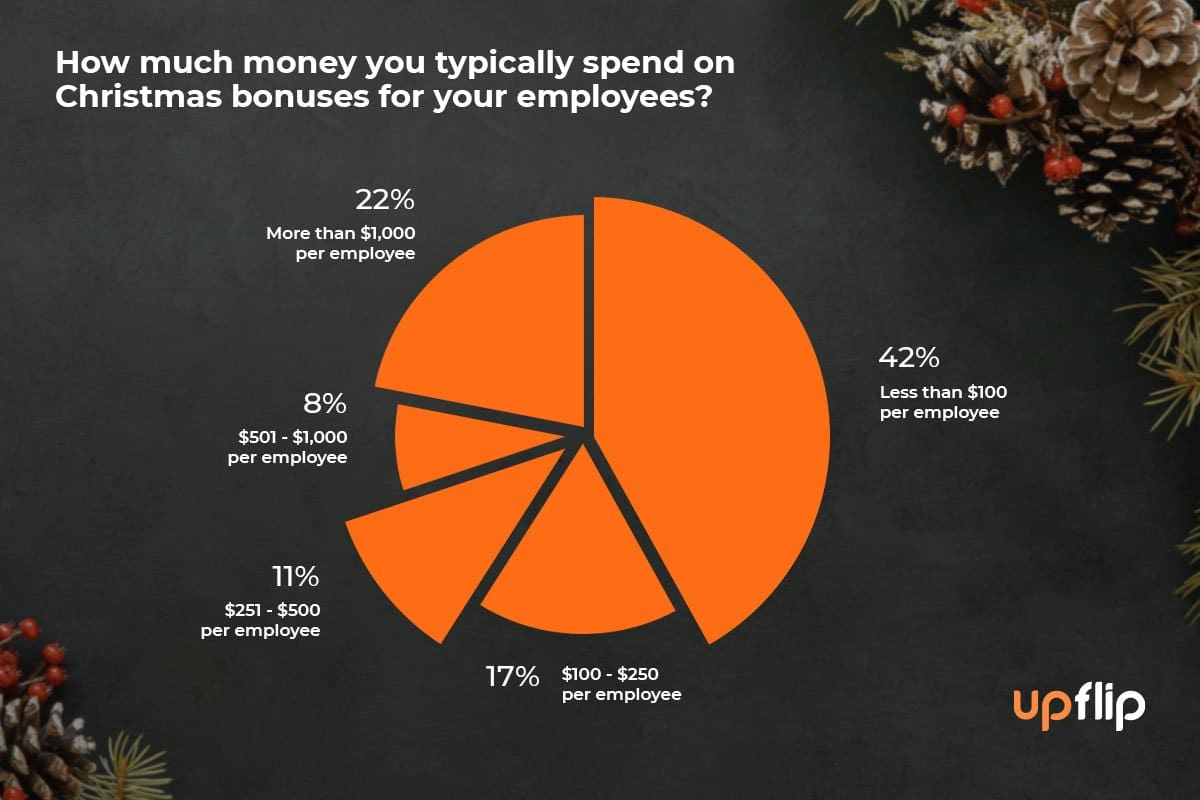It’s the season of giving, and all the Yuletide joy got us thinking about the ultimate stocking stuffer in the business world: How much is the average Christmas bonus?
Veteran and rookie business owners might wonder if they should offer holiday bonuses, and employees certainly want to know if they’ll receive extra cash. We conducted original surveys about expectations and employers’ intentions for year-end bonuses.
We’ll answer questions about the average holiday bonus and what bonus amounts employers and employees think are good with rising costs. We’ll also explain how to calculate Christmas bonuses and reveal the type of bonuses staff members prefer.
Read our findings from start to finish or click any link below to jump to the specific topic that interests you most:
Key Findings
- The average Christmas bonus is $851.97.
- Over 80% of respondents say year-end bonuses improve employee morale.
- Most respondents think a Christmas bonus equal to a week’s pay is adequate.
- 71% of Christmas bonuses are cash or one-time paycheck bumps.
- 20% give bonuses of more than $1,000 during the Christmas season.
- 42% of companies give less than $100 in Christmas bonuses per employee.
- Insufficient revenue is the main driver for not providing Christmas bonuses.
- 51% of companies plan to give a Christmas bonus in 2024.
What is the average Christmas bonus?
The average Christmas bonus is approximately $851.97.
We calculated this based on the average weekly pay in the U.S. and the weighted average of employers in each category. The chart below includes employers who don’t give bonuses or give a bonus equal to a day, week, or month’s pay.
| Average Christmas Bonus | ||
| Basis | Salary | Percent of Employers |
| None | $0.00 | 49.00% |
| Weekly | $1,165.00 | 25.50% |
| Monthly | $4,951.25 | 10.71% |
| Daily | $166.43 | 14.79% |
| Average: | $851.97 | |
What is a Christmas bonus?
A Christmas bonus is a benefit that employers give during the holiday season. Giving employees Christmas bonuses isn’t required, but it shows employees you care and lets them share in the profits of the company. In fact, 84% of people believe that Christmas bonuses improve employee morale.
UpFlip pays out Christmas bonuses, so we asked our CEO, Sergei Belous, for his take. He said:

How much is a Christmas bonus?

A Christmas bonus is up to management based on the performance of the company, a person’s length of time with the company, and the industry.
Companies’ year-end bonuses vary widely:
- 42% of companies give each employee holiday bonuses less than $100.
- 22% give over $1,000 for Christmas bonuses.
- 19% give holiday bonuses between $251 and $1,000.
- 17% give Christmas bonuses between $100 and $250.
How much should a Christmas bonus be?
You should provide an end-of-the-year bonus that’s equal to between one day and one week of employee base pay. A Christmas bonus should be enough money to incentivize employees to help the company succeed.
Making employees feel valued will boost morale and employee engagement. It also helps reduce stress because many employees rely on the annual bonuses to help offset higher costs.

What is a good Christmas bonus?

Any Christmas bonus is a good Christmas bonus. Roughly 48% of employers did not give employees holiday bonuses in 2023.
Survey respondents let us know how much a good Christmas bonus should be:
- 50% of employees consider a week’s pay to be a good Christmas bonus.
- 21% are okay with a day’s pay or less.
- 29% consider a month’s pay or more to be adequate.
We expect more employers to skip holiday bonuses or reduce the amount in 2024 due to costs. According to the Small Business Index, 56% of small businesses cite inflation as a primary concern.
How to Calculate Christmas Bonus
There are three main ways to calculate a Christmas bonus. Make sure to check your company policy to make sure that there aren’t existing policies about holiday bonuses.
- Percentage: Multiply the employee’s salary by 2% to 5% to come up with a bonus using this method.
- Flat-rate cash bonuses: You may choose to give all employees equal cash bonuses based on their position and time with the company.
- Performance-based bonuses: Some companies give performance bonuses based on the financial performance of the company and the division.
In 2023 at UpFlip, we calculated the Christmas bonus by the average weekly pay of the employee during the previous month. During the week before, bonus payments were based on the average weekly pay for the year.
Both employers and employees should check their contract to see if there are any conditions in the contract that would dictate exact terms.
Example Bonus Calculation
The example below shows how to calculate percentage-based Christmas bonuses.
- Employee’s annual salary: $60K
- Company bonus policy: 5% of annual salary
- Calculation: $60K × 0.05 = $3,000 Christmas bonus
Employees Prefer Cash

Businesses that give Christmas bonuses like to keep it simple.
- 71% of survey respondents who provided year-end bonuses in 2022 gave their employees cash on paychecks.
- 21% give gift cards or days off.
- 8% gave something else.
One respondent’s company gave money, gift cards, and days off. That’s a Christmas miracle! If you received something other than money, gift cards, or days off, we’d love to hear from you in the comments.
While receiving cash bonuses on their paychecks may be nice, remember that taxes come out of it. After you withhold taxes, they’ll only get like 50% to 80%.
It will be up to the employee whether to report the monetary bonuses if you provide non-cash gifts, Visa gift cards, or cash.
Christmas Bonus FAQ
Is a Christmas bonus taxable?
Yes. According to H&R Block, a cash bonus should be reported on your W-2. You will need to report the bonus as wages on line 1 of Form 1040.
How much was Clark Griswold’s Christmas bonus?
In National Lampoon’s Christmas Vacation, Clark Griswold’s Christmas bonus would have been approximately $20,000 in 1989. This is based on the average salary for a chemical engineer in 1989 and the average cost of a swimming pool back then.
Our guess also assumes that a director in a major company would get a 25% bonus. Learn more in this Reddit thread.
Is $300 a good Christmas bonus?
A $300 bonus is a good Christmas bonus for people who work minimum wage or haven’t received a Christmas bonus before. A bonus of $300 would be on the low end of a good Christmas bonus for people making the U.S. median wage or higher. For those groups, it would be equivalent to one day’s work.
How to say thank you for a Christmas bonus
To say thank you for a Christmas bonus, express gratitude and wish your boss a happy holiday season.
Do Walmart employees get a Christmas bonus?
Yes. According to MarketWatch, Walmart part-time and full-time employees can get holiday bonuses of up to $1,000. The terms vary based on the number of hours worked and longevity with the company.
Should I give my cleaning lady a Christmas bonus?
Absolutely! You should give your cleaning lady a Christmas bonus of 15% to 20% of her annual wages or up to the cost of one visit. You can give it as cash, gift cards, or gift baskets. Most people like deciding how to spend their holiday bonuses, though.
That’s the answer for how much of a Christmas bonus to give for a housekeeper too.
How much Christmas bonus for a nanny?
You should give your nanny a Christmas bonus equal to one week’s pay if they’ve been with your family for more than a year. One day’s pay per month worked is a good year-end bonus for nannies that have been with your family for less than a year.
What are other benefits to give employees during the holidays?
There are other special perks you can give employees to help reduce the stress of the holiday season. Consider the following options:
- Physical gift cards
- Paid time off
- Flexible hours
- Christmas party
Most employees appreciate being rewarded for their hard work. After all, between 25% and 50% of an employee’s year is spent getting ready for work, traveling to the job, and working.
Are you giving (or getting) holiday bonuses?
The Christmas season is a time of joy, but it also comes with increased costs and stress for many people. We established that the typical Christmas bonus is $851.97 of cash benefits on employees’ regular paychecks. We also explained that most people think either a day or a week of pay is a good bonus.
Most businesses benefit from happy employees. Don’t worry about giving the same bonus as last year because each year’s earnings, cash flow, and labor costs are different.
We know it’s been a challenge this calendar year with inflation, labor shortages, an election year, and other factors. Just do the best you can for your staff members to raise morale.
We’d love input from more companies. How do you handle Christmas bonuses?




